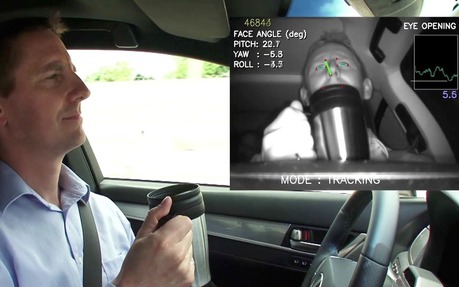Facial Recognition, the Future of Theft Protection?
With new technology appearing every day and hackers finding new ways to bypass security, how much time before automobile keyless systems can no longer offer the security we expect? Probably sooner than we think and a solution to this problem may be in our faces, quite literally.
At the recent Toyota Safety Seminar in Detroit, Toyota showed a driver alert system using facial recognition through a steering-column mounted camera. The camera tracks head and eye movement to spot signs of distracted driving and fatigue using face recognition algorithms (see: Toyota Becomes a Major Player in the Safety Arena). With deployment of this system less than a few years away, can these cameras also use face recognition for owner authentication and theft protection? Probably, but how robust is face recognition?
Studies indicate that the most distinctive facial features: nose, lips, eyebrow contours and the distances between these features hardly change over our lifetime. In fact, the Chinese Academy of Science is deploying an app next year using this as the new method to authenticate electronic payments. Today, some border controls use it and certain companies already use facial recognition to unlock their phones. As car-mounted cameras proliferate, adding facial recognition as another level of security appears feasible.
During a brief discussion at the seminar on this very subject, the thread quickly moved toward the craziest possibilities. Then again, are they?
Picture this; at the time of new car delivery, the dealer scans the owner’s face and enters a profile, matching the face, in the car computer. This process only takes minutes. The owner becomes the “administrator” and authorized to use all the car features. Other persons allowed to drive the car also enter a face scan with a profile indicating their tastes and/or restrictions. We’re not talking just seat, steering wheel and mirror adjustments here but, audio volume, maximum speed, distance travelled, the limit is near infinite. Sounds much better than a simple valet key or, those “reduced-performance” keys for the teenager in your home, doesn’t it.
Of course, there are many issues to deal with such as securing the data and preventing downloads during vehicle servicing and, of course, the occasional valet at the local club or hotel. Sure, some important details need ironing out but at the pace of today’s technology, these are mere blips on the endless path to more connected cars.
In any case, the exercise turned out to be a lot of fun and, interestingly, everyone agrees the technology is right around the corner. Just another way of showing how technology can make tomorrow’s cars more secure and more interesting.
Remember, you read it here first!
